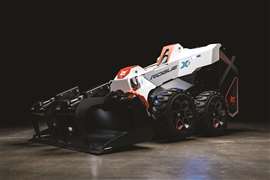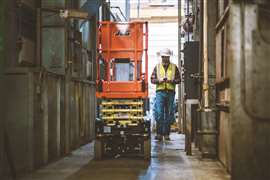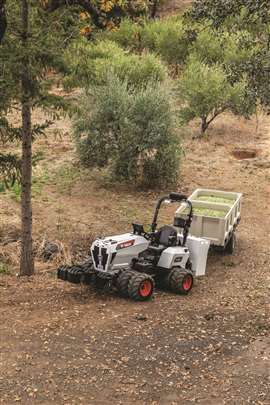The future is now for autonomous equipment
16 September 2024
There’s a lot of talk about “the jobsite of the future” — a place and time where electrification, autonomous technology and intelligent processes combine to drive efficiencies, maximize safety and increase overall productivity. Lindsey Anderson investigates.
These ideals may seem like a far-off concept that’s years away, but with the industry taking continuous steps toward connection and optimization, that future has already arrived. And this transition, according to Rogerio dos Santos, vice president of strategy and product management at JLG, is transpiring not all at once, but instead in stages, or, “moments of autonomy.”
“It’s not going to be like one day you’re on a totally disconnected jobsite, and then the next day, it’s a completely new world,” dos Santos says. “It is actually happening now.”
One step at a time
 Doosan Bobcat officially introduced the all-electric and autonomous RogueX2 loader at Conexpo in 2023.
Doosan Bobcat officially introduced the all-electric and autonomous RogueX2 loader at Conexpo in 2023.
In July, Doosan Bobcat’s board of directors announced its plans for Doosan Robotics to complete a merger with Doosan Bobcat by early next year. Under the plan, Doosan Bobcat would become a wholly owned subsidiary of Doosan Robotics. In a company presentation, Doosan said the strategy is part of a plan to “become a global full-range autonomous/automated solution provider.”
“We think of technology related to electrification, autonomy and advanced connectivity as building blocks,” says Joel Honeyman, Bobcat’s vice president of global innovation.
Honeyman, who has been with Bobcat for more than 27 years, leads a dedicated team that works across those three technology pillars, and through partnerships with tech companies and providers, has created solutions that Bobcat can implement across a range of its product categories.
“For the last five years, we’ve been doing quite a bit of active work,” Honeyman says. “For example, we invested in a radar company in Kansas called Einstein, and this is our collision warning and avoidance system that we’re piloting right now, which will be commercialized here by the end of the year.”
That ‘active work’ Honeyman and his team have been conducting has seen Bobcat debut a number of autonomous prototypes and concepts over the last few years, including the Bobcat AT450X enabled by Agtonomy, the all-electric and autonomous RogueX2 loader, an autonomous mower designed to operate with Greenzie software, as well as the company’s MaxControl remote operation, Bobcat Machine IQ and more.
Could Bobcat telehandlers be next?
“We are working across different areas because it’s not ‘one-size-fits-all,’” Honeyman explains about utilizing tech across different products. “We’re certainly looking to apply these similar technologies to our telehandler family.”
Currently, Bobcat is looking into systems that detect if an operator is in the seat of a telehandler or wheel loader’s cab. “This technology would lend itself to enable the controls to be activated within the equipment,” Honeyman explains. “We’ve also looked at applying radars for collision warning and avoidance.
“These things are coming together under a strategy, but the solutions are unique depending on the vehicle and the application.”
Less labor? More robots
Since the dawn of the Industrial Revolution, successive waves of technology have made work significantly more productive and safer, and workers’ roles have also evolved. For example, until the 1970s, most factory
 JLG’s Mobile Control allows operators to drive, steer and load stowed scissor lifts from a mobile device. (Photo: JLG)
JLG’s Mobile Control allows operators to drive, steer and load stowed scissor lifts from a mobile device. (Photo: JLG)
production work was performed by manual labor. During this decade, many manufacturers adopted robots for welding applications that required a high degree of precision. In part, they also adopted these automated solutions to compensate for a shortage of skilled labor. During this factory floor revolution, the role of human workers evolved to focus on oversight and inspection.
“The hunt for autonomous machines and technologies is not new,” says dos Santos with JLG. “If we want to envision where robotics in access equipment is headed, a great place to start is how it’s now being used in adjacent product categories and industries.”
The automobile industry is one industry that is consistently 5-10 years ahead of the construction industry. With automobile OEMs, technology follows a familiar path: New technologies are often first introduced on luxury vehicles because of their initial high cost. As these technologies mature, they are adopted by more consumers and build economies of scale; then, they move downstream to less expensive car brands. Examples include self-driving cars, active body control and adaptive cruise control. All involve autonomous or semi-autonomous vehicle control, which could be broadly considered a type of robotics.
While the construction industry hasn’t moved to fully autonomous equipment yet, there have been plenty of flashes of innovation with equipment offering steps toward autonomy, dos Santos explains.
“This evolution in autonomy, and in turn robotics, is not just about replacing human effort but enhancing the overall efficiency and accuracy of the job at hand,” dos Santos says. “The biggest driver in advancing autonomy and robotics in access equipment is the constant need to improve productivity, streamline repetitive processes and reduce operating costs. Robotic technology can handle repetitive tasks faster and at a more consistent level of quality.”
Examples already being used in both work-at-height and material handling applications include self-leveling, load sensing and variable tilt. These features allow MEWPs and telehandlers to adjust independently to changing conditions, enhancing precision and efficiency. For instance, self-leveling ensures that the equipment remains stable, even on uneven ground, reducing the need for manual adjustments. Load sensing allows the machine to detect and respond to variations in weight, optimizing performance and preventing overload. Variable tilt enables the equipment to adapt its angle automatically, ensuring optimal operation across different scenarios.
 JLG’s self-leveling chassis technology, seen here on a JLG 670SJ boom lift, automatically levels the unit on slopes up to 10 degrees. (Photo: JLG)
JLG’s self-leveling chassis technology, seen here on a JLG 670SJ boom lift, automatically levels the unit on slopes up to 10 degrees. (Photo: JLG)
“An example is JLG’s unique self-leveling chassis technology, which allows the JLG 670SJ boom lift to automatically level on slopes up to 10 degrees, enabling operation on uneven job site terrain. This innovative technology promotes safe operation and increases maneuverability, eliminating constant repositioning and saving time,” dos Santos says.
Honeyman explains that Bobcat sees autonomy and technology solutions as a means to combat the ongoing labor shortage.
“The one thing I always mention is that these solutions are not necessarily about removing the operator,” Honeyman says. “We think about, ‘How do we supplement labor better? And how do we support the current labor that we have?’”
Boosting safety and efficiency
Now, more than ever, access equipment manufacturers are searching for ways to boost equipment safety and efficiency by using automated solutions, dos Santos notes.
“For example, the safest place for operators is on the ground. Access OEMs can help keep operators on the ground with robotics and autonomy, making strenuous work less taxing and making high-risk tasks significantly safer. Reducing the physical and safety barriers can lower the overall hazards associated with construction jobs. This shift benefits current workers by making their jobs more manageable and efficient; it also has the potential to attract a new, diverse workforce. People who previously viewed construction as too physically demanding or hazardous might now see it as a viable and appealing career option.”
JLG has been working alongside Palladyne AI and Construction Robotics to collaborate on future machine concepts and solutions.
Through its partnership with Palladyne AI, JLG supplied a 450AJ articulated boom lift to be used as the
 Bobcat’s autonomous and electric articulating tractor, the AT450X enabled by Agtonomy. (Photo: Bobcat)
Bobcat’s autonomous and electric articulating tractor, the AT450X enabled by Agtonomy. (Photo: Bobcat)
Autonomous Working Vehicle (AWV) in a proof-of-concept project called Outdoor Autonomous Manipulation of Photovoltaic Panels (O-AMPP), which automates the transfer, lifting and placement of solar panels during installation, dos Santos says.
“This project involved rigorous field trials to test the feasibility and functionality of the autonomous system in real-world conditions,” he notes. “Palladyne AI successfully completed the system’s final validation last year, marking a significant milestone in the initiative.”
Through its work with Construction Robotics (CR), JLG has also supplied two machines for integration with CR’s new battery-powered compact MZ100 Material Unit Lift Enhancer (MULE): a JLG RT3394 scissor lift and a Hinowa TPX4000 tracked pallet jack.
JLG says this initiative aims to use robotics on machines commonly used by masonry and concrete contractors to lift and place concrete blocks, removing the cumbersome, repetitive construction task that often results in cumulative injury.
“As we move forward, we are focused on enhancing our capabilities and expanding our offerings, including looking for ways to increase operational efficiencies through more advancements in robotics and autonomy,” dos Santos says. “There’s no question that robotics for MEWPs will follow the same technology curve we’ve seen in other industries. By staying ahead of industry trends and leveraging our acquisitions, we aim to benchmark new standards in efficiency, sustainability and overall jobsite performance.”
CONNECT WITH THE TEAM





